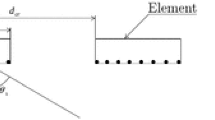Abstract
In the recent past, Non-Destructive Testing (NDT) methods play a significant role in welding defect detection. Phased array ultrasonic testing is the advanced NDT testing method that is used for accessing the weld integrity. But qualified personnel are required for measuring the geometrical features of the defects in welds. A full-fledged computer-based measuring system is very much required IN ORDER To avoid Manual interpretation, since, it always leads to some errors in inferring the Phased Array (PA) signals and images. This work proposes an artificial intelligence- based measuring approach to enhance the features of the image. The 2D Adaptive Anisotropic Diffusion Filter (2D AADF) is used to remove noise and also scattered pixels are corrected by applying a hexagonal sampled grid. The adaptive mean adjustment (AMA) algorithm would be used for enhancing features of the image in terms of contrast and brightness. The hybrid clustering segmentation incorporates non overlapping K means improved Fuzzy C Means (FCM) pixels clustering. The automatic seed point is selected by K means clustering, and high-intensity gradient is estimated by applying Gradient Cluster Fuzzy C Means (GCFCM) segmentation method. After segmenting the Region of Interest (ROI), the features are estimated due to Gray Level Co-Occurrence Matrix (GLCM). The computed segmented image features are further given to deep learning to classify different stages of welding defect. The investigational results are proven that the proposed algorithm would be high professional and accurate. The above technique is also implemented on the images acquired from the Omniscan MX2 instrument with a suitable linear array probe with 64 transducer elements in it. The proposed work aims to propose an automatic measurement technique for identifying the defect and characterizing it.











Similar content being viewed by others
References
Almahfud MA et al (n.d.) An effective MRI brain image segmentation using joint clustering (K-Means and Fuzzy C-Means). 2018 International seminar on Research of information Technology and Intelligent systems, IEEE, p 11–16
Barbu T (2018) Novel hybrid fourth-order anisotropic diffusion model for additive noise filtering. ICSEE International Conference on the Science of Electrical Engineering. https://doi.org/10.1109/ICSEE.2018.8646115
Bean E (2008) Defect Prevention and Detection in Software for Automated Test Equipment. IEEE Instrum Meas Mag 11(4):16–23
Dang C, Gao J, Wang Z, Chen F, Xiao Y (2015) Multi-step radiographic image enhancementconforming to weld defect segmentation. IET Image Process 9(11):943–950
Xinghui Dong, Chris J, Cootes TT (2018) Automatic inspection of aerospace welds using x ray imagess. 24th International Conference on Pattern Recognition. https://doi.org/10.1109/ICPR.2018.8545738
Foudazi A, Ghasr MT, Donnell KM (2015) Active microwave thermography for defect detection of CFRP-strengthened cement-based materials. IEEE Trans Instrum Meas 64(9):2583–2585
Foudazi A, Ghasr MT, Donnell KM (2015) Characterization of Corroded Reinforced Steel Bars by Active Microwave Thermography. IEEE Instrum Meas Mag 64(9):2583–2585
Yingjie LZ, Bochao D, Bo C, Yangfan L(2019) Welding defect detection based on local image enhancement. IET Image Process. 13(13), 2647–2658
Liu Z, Lu G, Liu X, Jiang X, Lodewijks G (2017) Image processing algorithms for crack detection in welded structures via pulsed eddy current thermal imaging. IEEE Instrum Meas Mag 20(4):34–44
Liu K, Wang H, Chen H, Erqing Q, Tian Y, Sun H (2017) Steel surface defect detection using a new Haar–Weibull-variance model in unsupervised manner. IEEE Trans Instrum Meas 66(10):2585–2596
Liu J, Mingrui F, Liu F, Feng J, Cui K (2018) Window feature-based two-stage defect identification using magnetic flux leakage measurements. IEEE Trans Instrum Meas 67(1):12–23
Liu K, Luo N, Li A, Tian Y, Sajid H, Chen H (2020) A new self-reference image decomposition algorithm for strip steel surface defect detection. IEEE Trans Instrum Meas 69(7):4732–4741
Perona P, Malik J (1987) Scale space and edge detection using anisotropic diffusion. Proceedings of IEEE Computer Society Workshop on Computer Vision. IEEE Comput. Soc. Press, Washington, DC, p 16–22
Qi A, Bai H, Liu T, Wu H (2016) Welding defect signal detection based on particle swarm optimized ICA algorithm. IEEE
Shen Y, Ge W, Wang X (2018) Detection of weld defects based on incremental two-dimensional principal component analysis. IEEE International Conference on Mechatronics and Automation (ICMA) 2018:329–334. https://doi.org/10.1109/ICMA.2018.8484533
Su B, Chen H, Zhu Y, Liu W, Liu K (2019) Classification of manufacturing defects in multicrystalline solar cells with novel feature descriptor. IEEE Trans Instrum Meas 68(12):4675–4688 (Dec.)
Sun J, Li C, Wu X-J, Palade V, Fang W (2018) An effective method of weld defect detection and classification based on machine vision. IEEE
Ngon Dang Thien, Chi CL, Ha Nguyen Ngoc (2017) An approach to the automatic detection of weld defects in radiography films using digital image processingg. Materials science. International Conference on System Science and Engineering (ICSSE). https://doi.org/10.1109/ICSSE.2017.8030899
Wu Y, Gao B, Zhao J, Wang Y, Liu Z, Chen J, Yin Y, Tian GY (2018) Weld crack detection based on regionelectromagnetic sensing thermography. IEEE
Wu J, Zhu J, Xia H, Liu C, Huang X, Tian GY, Senior (2018) DC-biased magnetization based eddy current thermography for subsurface defect detection IEEE
Zhan X, Jin S (2009) Signal analysis method for automatic flaw classification on pipeline girth weld inspection by ultrasonic phased Array system. IEEE
Haodong Zhang, Zuzhi Chen, Chaoqun Zhang, Xi J, Xinyi Le (2019) Weld defect detection based on deep learning method. materials science, computer sciencee.IEEE 15th International Conference on Automation Science and Engineering (CASE). https://doi.org/10.1109/COASE.2019.8842998
Author information
Authors and Affiliations
Contributions
In this research paper the C-scan images where acquired from the MX2 Olympus equipment for validation purpose. The obtained images are analyzed and the results are evaluated to show the effectiveness of the research carried out.
Corresponding author
Ethics declarations
Conflict of interest
The authors declare no conflict of interest.
Additional information
Publisher’s note
Springer Nature remains neutral with regard to jurisdictional claims in published maps and institutional affiliations.
Rights and permissions
About this article
Cite this article
Jayasudha, J., Lalithakumari, S. Weld defect segmentation and feature extraction from the acquired phased array scan images. Multimed Tools Appl 81, 31061–31074 (2022). https://doi.org/10.1007/s11042-022-13030-8
Received:
Revised:
Accepted:
Published:
Issue Date:
DOI: https://doi.org/10.1007/s11042-022-13030-8




